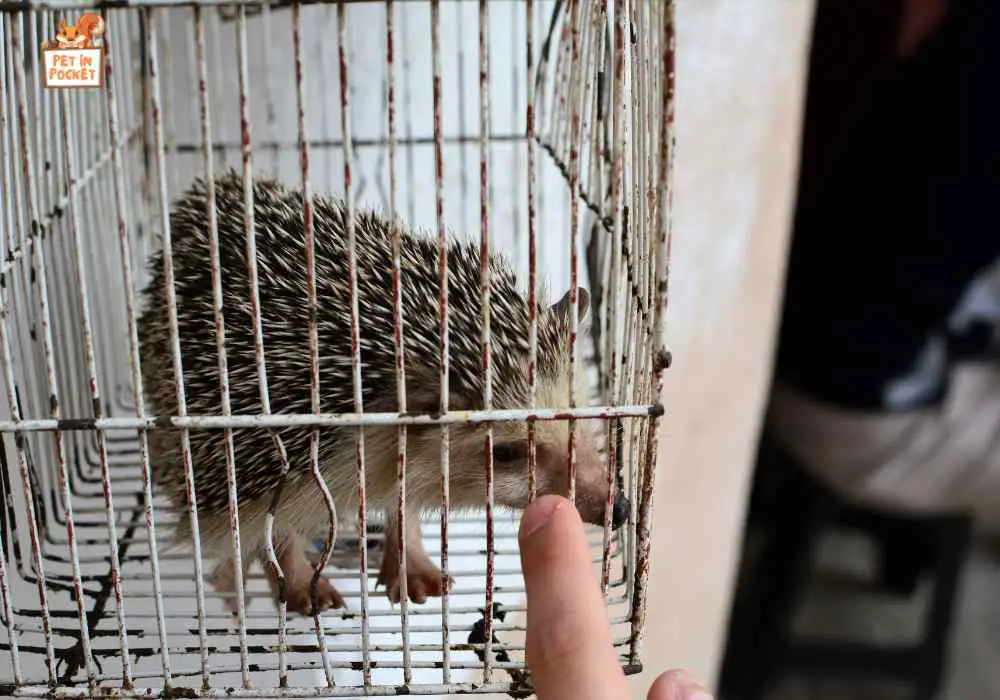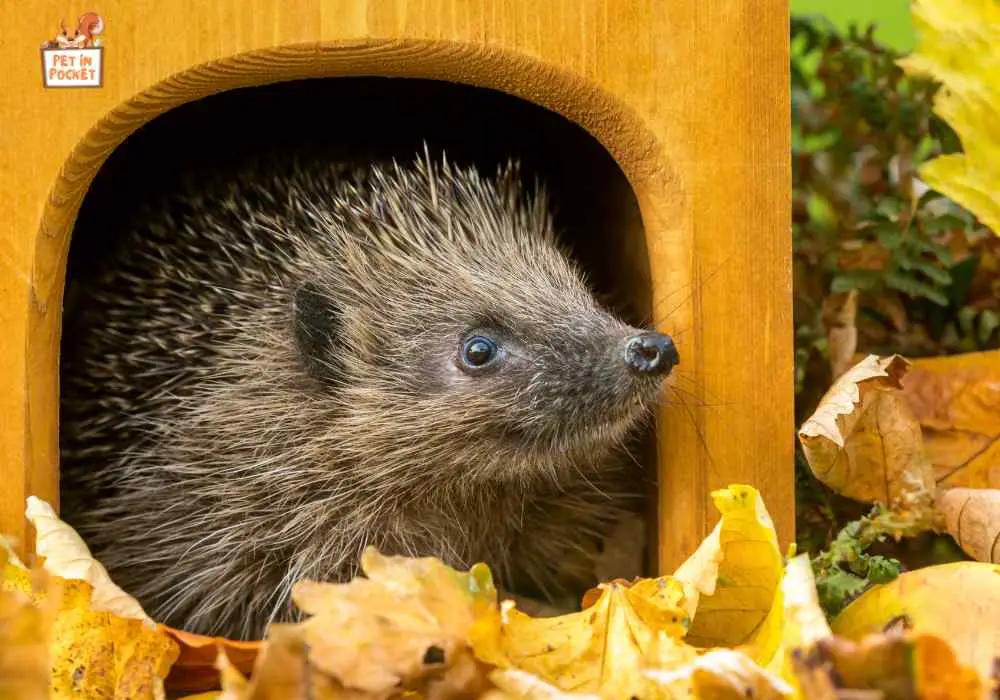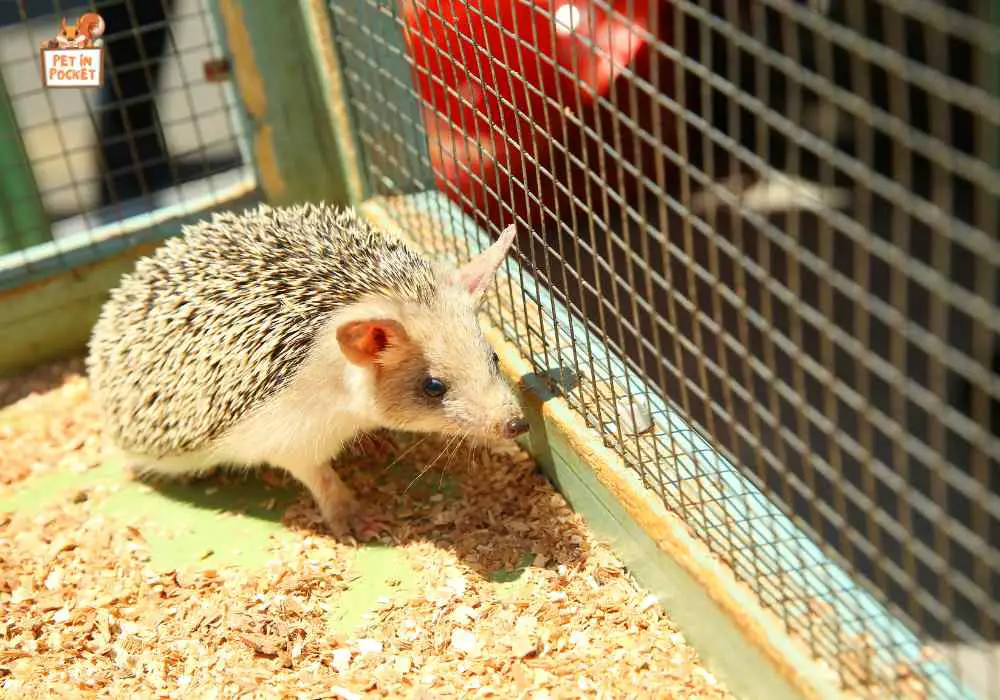Last week, my friend bought a cute little hedgehog and tried his best to make a cozy home for it. But the cage turned out to be too congested for his new buddy. Unfortunately, most newbies make this mistake and bring a wrong-sized enclosure for their pets. So, exactly how big should a hedgehog cage be?
A 2-square-foot cage with a wheel inside is acceptable for a hedgehog. However, these animals tend to run miles after the dark. Hence, a larger enclosure is better. The recommended cage size for hedgehogs is 6 square feet.
Keep reading to find details on hedgehog enclosures.
Table of Contents
How Big Does A Hedgehog Cage Need to Be?
There are many schools of thought available on the ideal hedgehog cage size. Though opinions vary, all experts agree on one point. The wider the space, the better it is for the pet. Your hedgehog requires the floor because it loves to stroll during the night.
These quill balls are nocturnal animals, and their main activity starts after the dark. An article in The Guardian suggests that wild hedgehogs can cover up to 12 miles in search of food. Even in captivity, the instinct pushes the creatures to move from one corner to another. This is why these prickly little pigs thrive in wider spaces.
Then, how big should a hedgehog cage be? Some experts suggest a 4-square-foot enclosure for the pets. However, we do not believe in such a generic answer.
Instead, we recommend our readers go through 2 matrices first. Later, they can compare their situation to the scenario and choose the right cage size for their hedgehogs.
1. The Bare Minimum Size
Frankly speaking, hedgehogs do not occupy a large space. We still aim for the bigger enclosure because these creatures love roaming around. The Spruce Pets confirms that 1 foot by 2 feet is the minimum cage size for your prickly pigs.
Of course, it is better if you can manage a habitat of 2 feet by 2 feet. In any scenario, maintain the enclosure height at least 1 ½ feet.
Now, we do not encourage keepers to follow this bare minimum size. The more space, the more the pets can stroll and the healthier they live. But obviously, not all of us can manage the space to accommodate the cage.
Therefore, use this measurement only if you install a wheel inside the habitat. Running on the wheels will make up for foraging or strolling.
Many keepers make their hedgehogs use the small cage only for sleeping and resting purposes. For exercise, they set the animals free outside in a secure room. Though the idea sounds risky, it definitely works.
2. The Ideal Size
We advise you to go for a bigger cage if you can manage the space. An enclosure of 6 square feet (3 feet by 2 feet) is quite popular among the keepers.
Obviously, the baby hedgehogs can adjust to a smaller cage. Live Science suggests that a mature hedgehog can grow between 4 to 12 inches and require a larger space. In such scenarios, you might not want to limit the enclosure size to 6 square feet. We recommend getting a cage with 42 inches by 30 inches dimensions if your pets have healthy growth.
In both cases, the habitat height should be at least 18 inches or 1 ½ feet.
How to Choose The Right Cage for Your Hedgehog

A random container or box with the desired dimension will not serve as an ideal hedgehog habitat. However, you must focus on habitat setting and space management. Here are our tips on choosing the perfect home for your prickly pets.
1. No Compromise with The Space
We have made it very clear that hedgehogs require a large habitat. Go for a bare minimum cage if you have a space problem in the apartment. Otherwise, buy an enclosure with a floor area of 6 square feet.
Yes, we have been pushing you to settle for a bigger cage for your quill balls. However, there is a maintenance issue with enormous habitats.
Once the keeper becomes infrequent with the cleaning procedure, the enclosure becomes a breeding ground for the bacteria. It makes the pets sick more often.
2. Consider Ease of Access
Owners need to access the hedgehog’s housing 24/7 to deliver food, bring the pet out, or clean the floor. It means a spacious yet tight-fitting door must be present on the cage.
Spacious in the sense that you can put or take out stuff without struggle. Again, a tight-fitting door prevents any escape or accident.
Furthermore, mind the shape of the cage. Millermeade Farm’s Critter Connection says that the habitat must not be on the floor but on a table or a shelf. So, the enclosure shape and size must be such that it can be safely placed at a moderate height.
3. The Interior Decides The Size

When you settle for a bare minimum cage for the hedgehog, you really do not leave any room for decoration. Honestly, that is not healthy.
Hedgehogs demand sources of entertainment inside their enclosure. Otherwise, they will not only grow physically unfit but mentally tired. We suggest setting up the cage with fancy and interesting toys that keep these tiny pets busy.
Here are what you can put in a hedgehog cage:
| Climbing walls: | Pet Keen confirms that our little prickly balls try out climbing occasionally. A sheer and flat cage wall often leads to accidents and permanent injuries. We recommend wrapping the walls with plastic sheets to make the enclosure safe. These help the hedgehogs with smooth climbing and reduce the risk of a fall. |
| Ramp: | Keepers who can not afford horizontal space sometimes use multi-story cages. In such a setup, installing a ramp can be a fun way to escort the pet from one floor to another. |
| Hide Outs: | Our nocturnal hedgehogs are in love with the darkness. So, putting in small tunnels and other hiding toys (e.g., igloos, boxes, etc.) always helps them relax. |
| Balls: | These little prickly animals enjoy playing around with balls. We suggest putting medium-sized balls inside the cage. A hard plastic ball is better, as the hedgehogs might chew on softer plastics. |
| Toilet Paper Tube: | Though keepers find this an exciting toy, we are against this. Your plausible hedgehog might get stuck inside the narrow cylinder and hurt itself. We suggest buying spacious tunnels instead. |
| Wheels: | Our experience tells us to put a wheel in every hedgehog enclosure. Running on the wheels brings the wild vibe back. |
Of course, there are more varieties of toys available for hedgehogs. To decorate the enclosure with these supplies, you must aim for a bigger cage. Otherwise, you might just make the existing habitat congested.
4. Which Type of Habitat to Choose?
Keepers often make a grave mistake by putting their hedgehogs in wire floor cages. But your tiny pets can get caught in the wirings and injure themselves badly.
Therefore, buying an enclosure with a solid floor type is always encouraged. Or you can cover the bottom with a towel, plastic sheet, or a wooden plank.
Some popular hedgehog housing types are discussed below:
- Solid Floored Type Wired Cage: Lightweight, low price and well-ventilation make these enclosures the most popular. These cages are available in different sizes, and it is possible to customize the dimensions.
- Aquarium: Sure, you can turn the glass aquarium into a cozy home for your little prickly buddies. Just cover the top with a wired lid, and it will work. However, we do not recommend this type of housing due to the lack of ventilation.
- Plastic Containers: This is the cheapest option out there. However, the ventilation issue remains with this enclosure. Covering the top with a mesh and drilling holes in the side walls might help with ventilation.
5. Ventilation & Lighting

Hedgehog Cabin emphasizes a well-ventilated house for these creatures. Without the proper air passage, the enclosure will feel damp and unhealthy. That is why the wired cages serve as the best habitats for the hedgehogs.
Again, the animals require daylight for 12 – 14 hours. An enclosure that does not welcome daylight is of no use for them. If natural light is unavailable, leave a head space to install a bulb.
Conclusion
The minimum cage size for a single hedgehog is 2 square feet. But if you can manage space, aim for a dimension of at least 3 feet by 2 feet by 1 ½ feet. You might need to buy a bigger enclosure if you decide to decorate the home.
Frequently Asked Questions
Is it better to have 1 or 2 hedgehogs?
Hedgehogs are not social creatures. Housing multiple hedgehogs in the same enclosure will only cause fights. Thus, if you have more than 1 hedgehog, keep them in separate enclosures.
How many square feet do hedgehogs need?
The baby hedgehogs can fit inside a 2-square-foot cage. A mature one can also adjust to this dimension. But offering them a cage of a minimum of 6 square feet is better.
What cages are best for hedgehogs?
Wired solid floored cages are the best for hedgehogs. People often go for aquariums or plastic containers. However, these habitats are not suitable due to poor ventilation.
Do hedgehogs like tight spaces?
Hedgehogs look for tight spaces to burrow and hide. Yet, a larger cage is recommended. This is because hedgehogs tend to walk miles after dark.
Do hedgehogs like vertical cages?
Hedgehogs rarely utilize the vertical space in their cages and do not enjoy multistoried enclosures. Instead, they prefer the horizontal floor. Yet, a headspace is required for decorations and other setups.






Leave a Reply